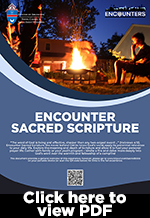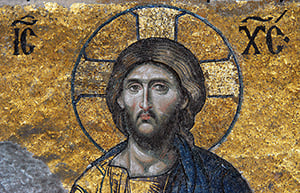
 “The word of God is living and effective, sharper than any two-edged sword …” (Hebrews 4:12). Encounter Sacred Scripture like never before! Get to know God's word; apply its relevance to your daily life. There is something welcoming and cozy about sitting around a campfire with a family or group of friends. While enjoying the warmth and fellowship of a campfire, explore the meaning and depth of Scripture and allow it to fuel your personal prayer life. This Encounter consists of four Scripture studies which revolve around stories of fire from the Scriptures. Allow this Encounter to teach young people how to read Scripture, apply it to their lives, and continue a regular practice of spending time with God's word! Photo credit: https://tinyurl.com/y4vehjgj
“The word of God is living and effective, sharper than any two-edged sword …” (Hebrews 4:12). Encounter Sacred Scripture like never before! Get to know God's word; apply its relevance to your daily life. There is something welcoming and cozy about sitting around a campfire with a family or group of friends. While enjoying the warmth and fellowship of a campfire, explore the meaning and depth of Scripture and allow it to fuel your personal prayer life. This Encounter consists of four Scripture studies which revolve around stories of fire from the Scriptures. Allow this Encounter to teach young people how to read Scripture, apply it to their lives, and continue a regular practice of spending time with God's word! Photo credit: https://tinyurl.com/y4vehjgj
What is Sacred Scripture?
To understand Sacred Scripture, we must understand some things about God - mainly, that he wants to reveal himself to us! He has been revealing himself to us since the beginning of human history. God is an incredible mystery in himself, and so, in his sheer goodness, he chose to reveal himself and his will to us! This is what we call Divine Revelation - God revealing himself to his people.
 Sacred Scripture is that part of Divine Revelation that is written down for us. Sacred Scripture is the word of God, put down into writing in the language of human authors. God inspired the human authors of Sacred Scripture to write down just what he wanted and nothing more. It contains the hope and promises of God's love, consolation in times of difficulty, and the Good News of our salvation in Jesus Christ! Photo credit: shutterstock
Sacred Scripture is that part of Divine Revelation that is written down for us. Sacred Scripture is the word of God, put down into writing in the language of human authors. God inspired the human authors of Sacred Scripture to write down just what he wanted and nothing more. It contains the hope and promises of God's love, consolation in times of difficulty, and the Good News of our salvation in Jesus Christ! Photo credit: shutterstock
We call Scripture the word of God, and indeed it is! But do you know who also is the Word of God? Answer: Jesus!
Jesus is the fullness of God's Revelation. He is the fullness of what God wants to say about himself, for he is God himself - consubstantial (of one substance) with the Father! Jesus says of himself: “the Father and I are one” (John 10:30), and elsewhere “whoever has seen me has seen the Father” (John 14:9). When Jesus speaks, God speaks. When Jesus teaches, God teaches. The Catechism of the Catholic Church (CCC) teaches us that “All Sacred Scripture is but one book, and this one book is Christ, 'because all divine Scripture speaks of Christ, and all divine Scripture is fulfilled in Christ'” - CCC 134. When we encounter Sacred Scripture - we are encountering Jesus, the Word of God and fullness of Divine Revelation. And indeed, then, also encountering the Father - in the power of the Holy Spirit. Reading Scripture, then, is one great act of encountering the Holy Trinity!
How did the Bible come about?
“Therefore, brothers, stand firm and hold fast to the traditions that you were taught, either by an oral statement or by a letter of ours.” (2 Thessalonians 2:15)
The Bible didn't just drop down out of Heaven the way we have it now. It developed over time.
The message of the greatness of God - in his creation of the world and his interaction with his people in Adam and Eve, Noah, Abraham, Moses and the prophets, was passed on over time in a great oral tradition, before being eventually written down. (There were some writings about God and his people in circulation before and after Christ but were not included in the Bible.) How was the official list of the books of the Bible determined? Answer: by the decision of the early Church.
The regional Church councils of Hippo (393 A.D.) and Carthage (397 A.D.) confirmed the 46 books for the Old Testament. This would later be solemnly affirmed at the Council of Trent in the 16th century. The official list of the books of the Bible is known as the Canon of the Bible or Sacred Scripture. There are 27 books in the New Testament.
The word Bible comes from the Greek word “biblos”, which means book. Interestingly, the Bible is best considered as a library of books - each with a common theme - that of God revealing himself and his plan for us.
What are the Old and New Testaments?
The Bible is divided into the Old and New Testaments. The Old Testament (the longer one), contains the story of God's plan for our salvation since the earliest times - starting with the creation of the world, the Adam and Eve story, and going right up to shortly before the birth of Christ. It contains important teachings about how to live our Faith in God (for example, The Ten Commandments), prayers and wise sayings (the Psalms and Proverbs, for instance) and the account of God's relationship with his people in the historical and prophetic books. There are 46 books in the Old Testament.
The New Testament contains writings directly about Jesus and the early Church. The Four Gospels, Matthew, Mark, Luke and John, make up the first four books of the New Testament. The CCC teaches us that the “Gospels are the heart of all the Scriptures 'because they are our principal source for the life and teaching of the Incarnate Word, our Savior' (Dei Verbum 18)” - CCC 125. After the Gospels, there are writings about the activity of the early Church, letters of Paul, Peter, and other Apostles, and finally the Book of Revelation, written by John the Apostle.
Fun fact: guess how many copies of the Bible are estimated to be printed each year? Answer below.
Why do Protestant Bibles have less books in the Old Testament?
There were two canons of the Old Testament in use among the Jews around the time of Jesus: the Hebrew (or Palestinian) canon and the Greek (or Alexandrian) canon. The Greek canon is also referred to as the “Septuagint”. The Greek canon, completed and in use by the 2nd century B.C., contained seven more books than the Hebrew canon. These books are known as the deuterocanonical books of the Bible. Deuterocanonical means “second canon” in Greek. Some refer to these books as “apocryphal”. The legitimacy of these books was disputed by some Jewish rabbis in the 1st century, A.D. The early Christian Church accepted the Greek canon, which included the deuterocanonical books, as the complete list of the inspired books of the Old Testament. Popular in Israel at the time, Jesus himself would have prayed and studied the Greek canon of scripture. This was the accepted version of the Old Testament among Christians until the time of Martin Luther (16th century), who chose to adhere to the Hebrew canon. As such, Protestant Bibles either do not contain the deuterocanonical books or list them in a separate section.
Translations
 The original language of the Bible is Greek and Hebrew. But since most of us are not Greek and Hebrew scholars - we therefore must read a translation of the Bible. Not all translations are alike! Some do a better job conveying the original text and meaning of the Bible than others. When it comes to translating the sacred text, there are two general approaches - one is to focus more on a literal translation of the text word for word (known as a literal translation); while the other is to focus more on making sure the meaning of the text is accurately conveyed (known as a dynamically equivalent translation). It's a bit tricky - because a point being made in the ancient Greek or Hebrew - might not sound right when simply translated word for word into a modern language. This is the task of translators of the Bible - to provide a faithful rendering of what the original text is saying while attempting to make a readable translation. While some less easily readable translations may be great for a deeper study especially when one is looking for a closer, more literal rendering of the ancient text. Photo credit: https://tinyurl.com/y5hk5zup
The original language of the Bible is Greek and Hebrew. But since most of us are not Greek and Hebrew scholars - we therefore must read a translation of the Bible. Not all translations are alike! Some do a better job conveying the original text and meaning of the Bible than others. When it comes to translating the sacred text, there are two general approaches - one is to focus more on a literal translation of the text word for word (known as a literal translation); while the other is to focus more on making sure the meaning of the text is accurately conveyed (known as a dynamically equivalent translation). It's a bit tricky - because a point being made in the ancient Greek or Hebrew - might not sound right when simply translated word for word into a modern language. This is the task of translators of the Bible - to provide a faithful rendering of what the original text is saying while attempting to make a readable translation. While some less easily readable translations may be great for a deeper study especially when one is looking for a closer, more literal rendering of the ancient text. Photo credit: https://tinyurl.com/y5hk5zup
This is a helpful Bible Translations Guide from Catholic Answers: https://www.catholic.com/tract/bible-translations-guide
Here is an approved list of translations from the United States Conference of Catholic Bishops (USCCB): https://www.usccb.org/offices/new-american-bible/approved-translations-bible
 In the fourth century, St. Jerome translated the entire Bible into Latin. His translation is known as the Latin Vulgate or the BibliaSacra Vulgata. St. Jerome famously stated “Ignorance of the Scriptures is ignorance of Christ” (CCC 133).
In the fourth century, St. Jerome translated the entire Bible into Latin. His translation is known as the Latin Vulgate or the BibliaSacra Vulgata. St. Jerome famously stated “Ignorance of the Scriptures is ignorance of Christ” (CCC 133).
“St. Jerome in his study” by Marinus van Remerswale Photo credit: ShareAlike 4.0 International (CC BY-SA 4.0) https://tinyurl.com/yyonl9gq
The Study of Sacred Scripture
As you may know, study of Sacred Scripture can be a very serious and robust academic discipline - there are many learned men and women who are Bible scholars out there! Popular in the Catholic Church here in the U.S.A. are Dr. Scott Hahn, Dr. Mary Healy, and Curtis Mitch, to name a few. While we are not all called to be a Scripture scholar, there are elements of God's word and the study of his word that are important for the mature Christian to bear in mind.
The Senses of Scripture
One important element to understanding Scripture is what is known as the senses of Scripture. One passage of Scripture often has multiple meanings. These meanings or senses are called the literal and the spiritual. The spiritual sense is further divided into the allegorical, moral, and anagogical (or eschatological). The literal refers to simply what the words convey according to “sound interpretation” (CCC 116). St. Thomas Aquinas teaches that “all other senses of Sacred Scripture are based on the literal” (Summa Theologica I).
The allegorical refers to the meaning of the text in Christ, or what the passage tells us about Christ. For instance, the Passover Lamb which was slain and then consumed is a sign or symbol of Christ who was slain for our sins and then consumed in the Eucharist.
The moral sense of Scripture teaches us how to live our lives.
The anagogical sense speaks of the final destiny of man in Christ, and in the fulfilled Kingdom of God.
The Catechism shares a “medieval couplet” which well summarizes the senses of scripture: “The Letter [literal] speaks of deeds; Allegory to faith; The Moral how to act; Anagogy our destiny” (CCC 118).
For more on the senses of Scripture - check out this article: https://www.catholic.com/magazine/print-edition/one-text-four-senses
It is estimated that over 100 million copies of the Bible are printed each year!